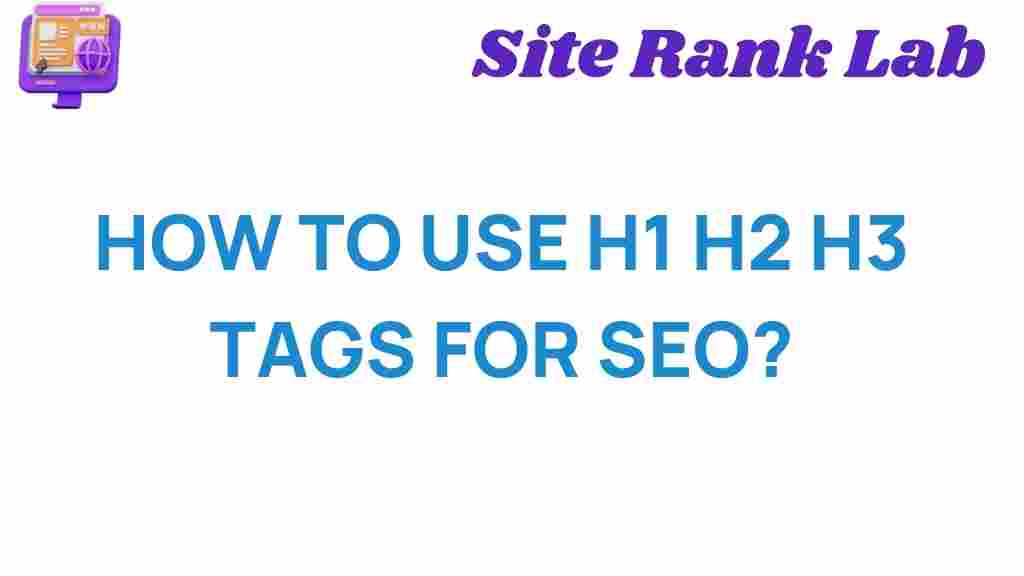Home > Blog > Unlocking SEO Success: Mastering H1, H2, and H3 Tags
Understanding SEO for Effective Website Optimization
Search Engine Optimization (SEO) is the cornerstone of a successful online presence. By mastering key elements such as H1, H2, and H3 tags, you can significantly improve your website’s visibility and search engine ranking.
In this guide, we’ll delve into the importance of these tags, how to use them effectively, and troubleshooting tips to unlock your website’s full potential.
The Role of H1, H2, and H3 Tags in SEO
Properly structured headings provide a roadmap for both users and search engines. They enhance readability and emphasize key content, helping search engines to understand the hierarchy and relevance of your page content.
- H1 Tags: Serve as the main title of your page, representing the primary topic.
- H2 Tags: Break down the content into sections, functioning as subheadings.
- H3 Tags: Offer further granularity by dividing H2 sections into smaller subtopics.
How to Optimize H1 Tags for SEO
H1 tags are crucial as they signal the primary focus of your content to search engines.
1. Use Keywords Strategically
Incorporate your primary keyword in the H1 tag, ensuring it aligns with the user’s intent. For example, a page targeting “SEO best practices” should have an H1 like “Top SEO Best Practices for 2024.”
2. Maintain Clarity and Relevance
Ensure your H1 tag succinctly represents the content on your page. Avoid stuffing it with multiple keywords, as this can confuse both users and search engines.
3. Avoid Duplicate H1 Tags
Each page on your website should have a unique H1. Duplicate H1s can dilute SEO efforts and mislead search engines about the focus of your pages.
Best Practices for Using H2 and H3 Tags in SEO
H2 and H3 tags play a pivotal role in structuring your content and enhancing its readability.
1. Divide Content Logically
Use H2 tags to introduce major sections and H3 tags for subsections. This not only helps search engines understand your content but also provides users with a better reading experience.
2. Incorporate Keywords Naturally
Include secondary keywords in H2 and H3 tags where appropriate. For instance, if your focus is on “SEO tools,” you might use an H2 like “Best SEO Tools for Beginners.”
3. Enhance Readability
Break down long paragraphs into smaller chunks under subheadings. This not only improves user experience but also keeps readers engaged longer, signaling content relevance to search engines.
Common Mistakes and Troubleshooting SEO Challenges
Even experienced webmasters can encounter challenges when optimizing heading tags. Below are common issues and solutions:
1. Overloading with Keywords
Issue: Keyword stuffing in heading tags can lead to penalties from search engines.
Solution: Use keywords sparingly and focus on providing value-driven headings.
2. Ignoring Mobile Responsiveness
Issue: Poorly structured headings can disrupt the user experience on mobile devices.
Solution: Test your website on multiple devices to ensure proper formatting.
3. Neglecting Internal Links
Issue: Lack of internal links can hinder navigation and SEO performance.
Solution: Incorporate links naturally, like this guide on SEO basics, to improve site navigation.
Enhancing SEO Through Other Techniques
While mastering heading tags is crucial, combining this with other strategies can amplify your results:
- Quality Content: Ensure your content answers user queries and adds value.
- Meta Descriptions: Write compelling meta descriptions that include primary keywords.
- External Linking: Reference authoritative sources, such as Google’s SEO guidelines, to boost credibility.
Conclusion
Mastering H1, H2, and H3 tags is a vital aspect of SEO that can dramatically enhance your website’s visibility and usability. By structuring your content effectively, avoiding common pitfalls, and combining heading optimization with other techniques, you can unlock the full potential of your SEO strategy.
Start implementing these best practices today to create a website that not only ranks higher but also delivers an exceptional user experience!
This article is in the category Guides & Tutorials and created by SiteRankLab Team
